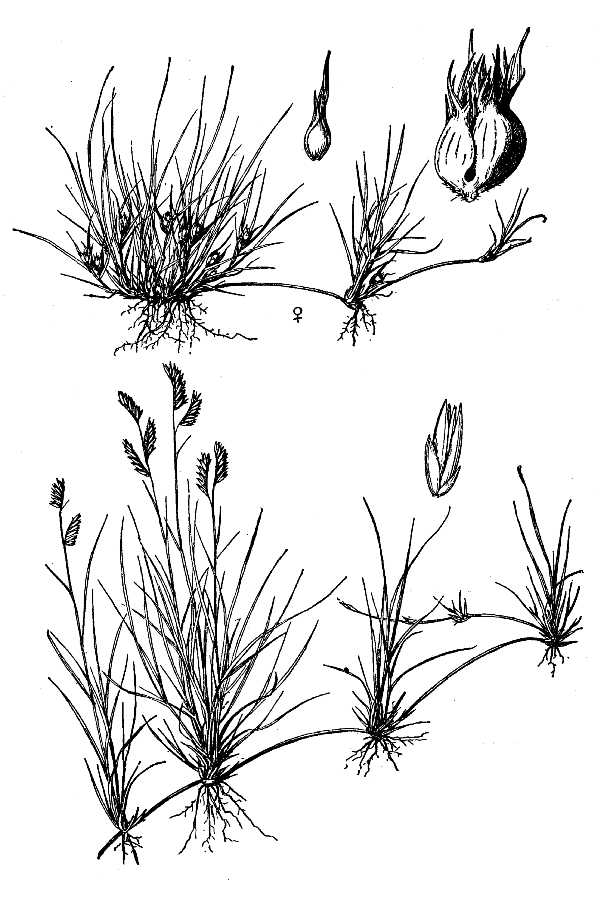 Drought Tolerant Buffalograss - April 10, 2013 Jeff Schalau, Agent, Agriculture & Natural Resources University of Arizona Cooperative Extension, Yavapai County Buffalograss (Buchloe dactyloides or Bouteloua dactyloides) is an excellent drought tolerant grass that can be used to create a lawn, informal meadow area, or to stabilize soil. It is native of Arizona found in small, isolated populations in Coconino and Gila Counties, but is much more common in the Great Plains from Montana to Minnesota and south to New Mexico, Texas, and Louisiana. This is one of the grasses that great herds of buffalo once grazed on and formed the sod early settlers used to build their houses on the prairie. Buffalograss is a low growing, warm season perennial. It can tolerate prolonged drought and extreme temperatures. The blue-green leaves of unmowed plants are commonly 8-10 inches and have very fine hairs on both upper and lower surfaces. The hairs are not obvious but this adaptation decreases air movement across leaf surfaces lowering potential water loss. Buffalograss is dioecious: individual plants are either male or female. The female cultivars (available as sod and plugs) are more compact (some as short as 4 inches) than the plants that originate from seed which will produce both male and female plants. Buffalograss spreads by stolons (above ground runners) that have internodes 2-3 inches in length. Each node on a stolon is a growing point that can take root and produce a new plant where it comes in contact with soil. At a glance, it looks similar to bermudagrass, but upon close inspection, buffalograss has no underground rhizomes. In other words, buffalograss can be controlled and contained easily. However, it cannot effectively compete with bermudagrass. Buffalograss can be established by sowing seed, planting plugs, or installing sod. Seeding is the least expensive. When purchasing, ask if the seed has been stratified (cold treated for 6-8 weeks) or chemically treated to break dormancy. If it has not, then it may not germinate until the following year. To prepare the seedbed, till the ground, rake smooth, remove rocks or debris on the surface, then roll with a water filled roller (these can be rented). Sow the seed in May or early June – if sown after July 15, it may not establish before winter. After sowing, rake the seedbed to bury the seed, roll it another time to ensure good seed-to-soil contact, and cover with a thin layer of weed-free compost. Sowing rates vary with your goals. Four to six pounds of treated seed per 1,000 square feet should germinate in 7-10 days and grow into a dense stand (lawn) in several months if given adequate irrigation. Do not over irrigate buffalograss after establishment. Planting plugs is relatively easy, but a bit more work. Plugs (as well as sod) should be planted in late May or early June. Prepare your planting area as described above. Plugs can be purchased from several sources online. Plugging simply requires transplanting them on 12-18” centers throughout the lawn area. The closer the plugs are spaced, the more quickly the area fills in. If establishing a lawn, a pre-emergent herbicide is strongly recommended during the establishment period to keep the weeds from growing and reduce competition. Buffalograss is a low maintenance turf that should be used in low traffic areas. It should not be mowed short - three inches or higher is recommended. Fertilization is optional and applications should not exceed two pounds of nitrogen per 1,000 square feet. One inch of water per week is adequate to maintain an established buffalograss lawn and excessive water encourages bermudagrass encroachment. Like bermudagrass, buffalograss will turn brown and go dormant when the weather cools off in fall and winter. During this dormant period, it will be straw-colored and should not be overseeded with any annual grasses (rye or others). I have included several additional resources, including seed/plug vendors, with the on-line version of this column (see URL below). Follow the Backyard Gardener on Twitter – use the link on the BYG website. If you have other gardening questions, call the Master Gardener help line in the Camp Verde office at 928-554-8999 Ext. 3 or e-mail us at cottonwoodmg@yahoo.com and be sure to include your name, address and phone number. Find past Backyard Gardener columns or provide feedback at the Backyard Gardener web site: http://cals.arizona.edu/yavapai/anr/hort/byg/. Additional Resources Click the small graphic to the left of the title above for a line drawing of male and female buffalograss plants. Buffalo Grass, Texas A&M AgriLife Extension http://aggie-horticulture.tamu.edu/archives/parsons/turf/publications/buffalo.html Turfgrass IPM Advisory – Good Buffalograss Article Included, Utah State University, Winter 2013 http://utahpests.usu.edu/IPM/files/uploads/Advisories-turf/turf-ipm-winter13.pdf 2012 Commercial Sources of Buffalograss Seed, Sod, and Plugs, Oklahoma State University http://pods.dasnr.okstate.edu/docushare/dsweb/Get/Document-7239/CR-6609web2012.pdf |